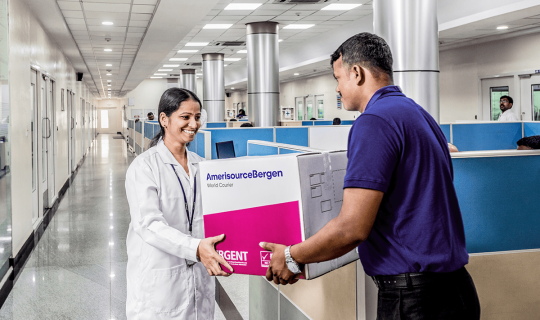Executive Summary: How to Reduce the Risks Created by Next Gen Biologics
By Ruediger Lomb
Shipping high-precision therapies can present significant challenges for stakeholders across the pharmaceutical supply chain. These products have strict time and temperature requirements to maintain efficacy and are both complex and costly to manufacture – meaning there is no room for error in storage, transit or delivery.
Read this executive summary to discover the benefits of investing in quality over cost-cutting in transporting these therapies as well as:
- The growing demand for specialty logistics
- The stakeholders most impacted by a temperature excursion
- The costs created by quality failures
Interested to find out more? Download The Cost of Quality in the Specialty Pharmaceutical Supply Chain to find out how to successfully navigate the distribution challenges of next generation biologics and how quality can act as a value creator to reduce overall supply chain costs.
Quality First: How to Reduce the Risks Created by Next Gen Biologics
A new quality-focused mindset is required to create robust risk management systems that add value for the organization, address distribution challenges, and generate better patient outcomes.
The pharmaceutical industry is changing dramatically. While the blockbuster drugs of the 1990s such as Lipitor® continue to play an important role in managing patient illnesses, industry focus is now shifting to delicate therapeutic products such as large molecule biologics and new molecular entities (NMEs), including innovative cell and gene therapies (CGTs).
Biologics represent significant challenges though; all are costly, complex to manufacture, in limited supply, usually temperature-sensitive with a short shelf life, and are often designed to treat small, geographically-dispersed populations suffering from rare or ultra-rare conditions.
The Growing Demand for Specialty Logistics
Managing such challenges has led to significant changes in the way a growing portion of pharmaceutical products are now handled with the industry increasingly turning to high-quality specialty logistics solutions that can manage:
- Rigorous transportation and storage requirements
- Ever-increasing supply chain complexity
- Growing regulatory oversight at local/international levels
- Precise delivery windows
- Increased data/security requirements
But what do modern logistics challenges actually look like? Consider these two real-life examples:
Individual therapies
Kymriah is a genetically modified autologous T-cell immunotherapy for treating acute lymphoblastic leukemia. Each dose of Kymriah is created from the patient’s own T-cells with the final product shipped in liquid nitrogen shippers at -120°C or lower.[1]
Nationwide programs
India's immunization program serves 27 million infants and 30 million pregnant women each year[2]. However, a 2012 study found up to 36% of test shipments containing 2-8°C vaccines were exposed to subzero temperatures while up to 66% were subjected to temperatures greater than 8°C[3] — failures that would significantly compromise product stability and potency.
As the above examples demonstrate, the impact of even a hypothetical 1°C temperature excursion outside specification on a high-value shipment can have a huge impact on stakeholders and patients. For instance:
QA Personnel
Output and productivity decreases as they investigate the excursion; the ‘due diligence’ required may cost upwards of $10,000 per excursion — whether or not the product is ultimately deemed usable.
Manufacturing
Accommodating an unscheduled production run requires a shift in focus and a reallocation of resources. Sourcing of APIs, unanticipated equipment change-overs and reorganization of the production schedule will likely come at a premium.
Sponsor/Pharmaceutical Company
The impact of a major product loss can be devastating, both financially and socially. In clinical trial applications for example, it can lead to study delays, loss of patients, compromised retention rates, delayed regulatory approvals, and loss of confidence by investigators, clinical staff and patients.
Counting the Cost of Failure & Quality
So what is the actual cost of a 1°C out-of-spec temperature excursion? In the worst case scenario — a temperature failure that results in total product loss — the numbers are staggering, with some industry analysts setting the total 2014 annual loss at approximately $35 billion.[4]
Key elements identified include lost product costs ($15.2 billion), root cause analysis ($8.6 billion), clinical trial loss ($5.65 billion), replacement costs ($3.65 billion), and wasted logistics costs ($1 billion). Such figures though don’t include the intangible costs such as the negative impact on patients; loss of reputation, credibility and goodwill; loss of revenue and reduced profitability, and more.
It means a risk management strategy and decision-making tree must be created that will ensure quality, all while managing costs. Part of the answer lies in understanding the true Cost of Quality in terms of manufacturing — and how its methods and practices should be adopted in distribution.
CoQ in Manufacturing
The Cost of Quality
(COQ) is typically defined by a product that meets quality expectations and a
product that does not. In manufacturing, the COQ is divided into two categories
— Prevention and Appraisal — while the Cost of Poor Quality is segmented
into Internal Costs and External Costs:

CoQ in Distribution
Although designed for manufacturing, these
categorizations are equally viable in distribution where the costs of failure
can be attributed to either:
Internal Costs: Product/productivity loss, QA, replacement
costs, return and destruction.
External Costs: Patient impact, study/product delivery
delays, re-recruitment, reputation/credibility and litigation.
In distribution, both the prevention and appraisal costs of COQ should include the cost of identifying and selecting the third-party logistics providers who are able to meet on-time and in-spec delivery expectations:
Prevention Costs: Capability assessments of logistics providers including QMS/compliance, facilities, packaging capabilities, reliability, on-time delivery rates, geographic scope, IT/data management capabilities, accreditation, training, experience, reputation, and incremental service costs for specified products/lanes.
Appraisal Costs: Supplier assessments, quality audits and
local inspections.
It’s worth
considering too that the incremental logistics costs will never outweigh the
costs associated with a significant high-value product loss generated during distribution.
Why Distribution Must Evolve
Most quality
innovation in the pharmaceutical industry over the past decade has originated
on the manufacturing side of the business, but today’s pharmaceutical shipper
will undoubtedly appreciate that quality does not stop at the factory door. In
the real world, true quality is only achieved when the right patient receives
the right drug at the right time and in the right condition, underscoring the
significance of post-manufacturing delivery as a critical part of both the supply
chain and the quality equation.
It is critical then
to now recognize transport and logistics as an extension of manufacturing
activities that must be subject to the same standards, scrutiny and oversight.
Indeed, they should be included in the overall risk assessment determined at
the beginning of the process as part of an all-encompassing
manufacturing/distribution protocol.
Face the Future
After all, in today’s world, the high cost and complexity of large molecule therapies, tightening bottom lines and intense competition have left no room for error in either product development or distribution — and with the global pharmaceutical cold chain expected to reach $16 billion by 2020, the focus on quality will and must continue to grow.
As an industry, we can no longer afford to be wrong; the errors are too costly, the fallout too far-reaching — especially for patients who rely on us all, day in, day out.
Take the Next Step
Discover how to successfully navigate the many manufacturing and distribution challenges of next generation biologics by:
- Identifying the true Cost of Quality — and Failure
- Understanding the impact of inefficient supply chains
- Analyzing the critical benefits of next gen logistics
- Uncovering vital insights through in-depth case studies.
[1] “FDA approval brings first gene therapy to the United States”, FDA News Release, August 30, 2017.
[2] Tiwari R et al,“A study to assess vaccine wastage in an immunization clinic of tertiary care centre, Gwalior, Madhya Pradesh, India”, International Journal of Research in Medical Sciences, June 2017.
[3] Murhekar, Manoj V., et al, “Frequent exposure to suboptimal temperatures in vaccine cold-chain system in India: results of temperature monitoring in 10 states”, World Health Organization Bulletin, 2013 Dec 1; 91(12): 906-913, Published online 2013 Sep 9. doi: 10.2471/BLT.13.119974.
[4] “Cold Chain Shipping Loss in Pharmaceuticals”, CargoSense, http://www.cargosense.com/cold-chainshipping-loss-in-pharmaceuticals.html.







